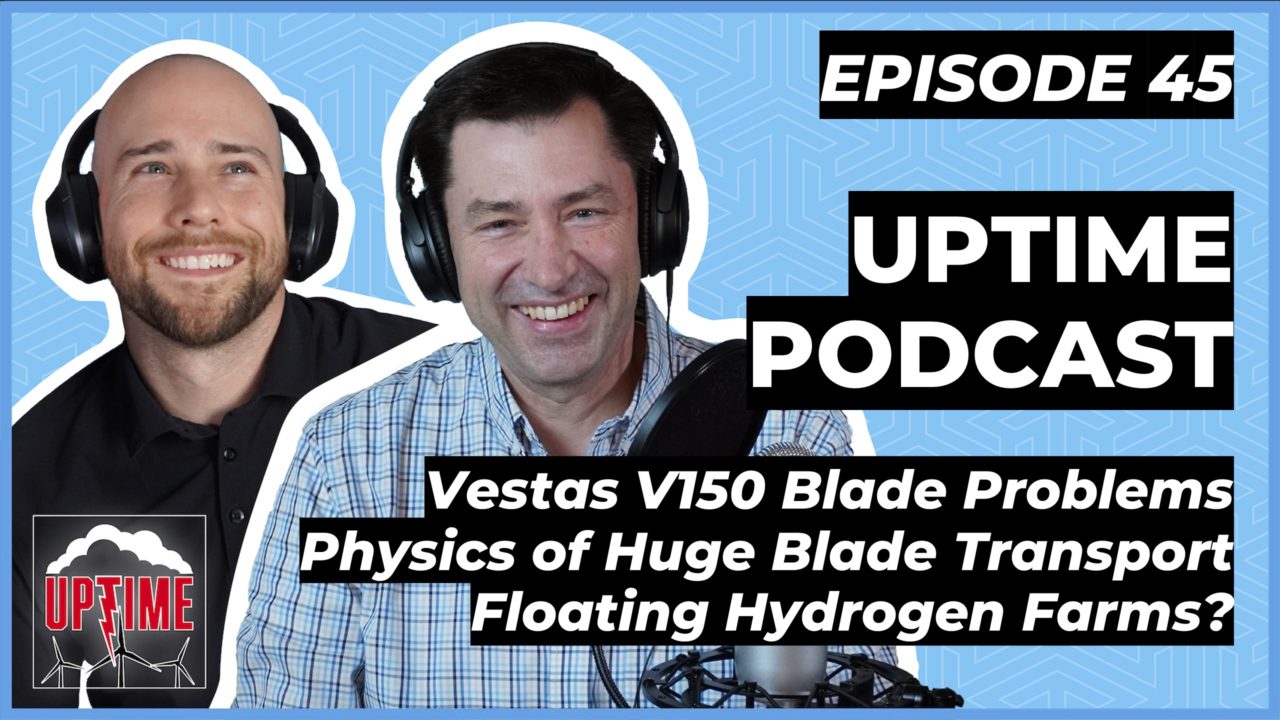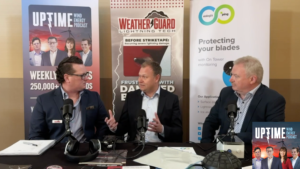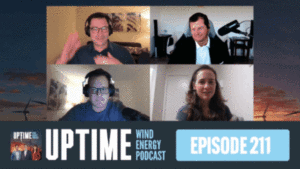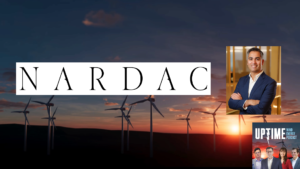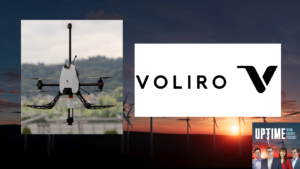Vestas V150 wind turbines have had failures and blade quality control issues lately, and we chat about what this means for the company, including their recent shut down of 150 wind turbines with suspected quality control issues. We also discus blade transport physics – how in the world do some of these massive blades not tip trucks over as they’re hauled through the mountains pointing into the sky at a 45 degree angle?! This and more on this week’s Uptime Wind Energy Podcast.
This episode is sponsored by Weather Guard Lightning tech. Learn more about Weather Guard’s StrikeTape Wind Turbine LPS retrofit. Follow the show on Facebook, YouTube, Twitter, Linkedin and visit Weather Guard on the web. Have a question we can answer on the show? Email us!
Podcast: Play in new window | Download
Transcript: EP45 Vestas V150 Blade Problems Plus the Physics of Blade Transport
I’m Dan Blewett and this is the uptime podcast where we talk about wind energy engineering, lightning protection, and ways to keep your wind turbines running.
welcome back to the uptime podcast. On today’s episode, we’re going to get down the rabbit hole on. Vestas a V one 50 blades. They’ve had to stop 150 turbines. They’ve had some quality control issues where a chat through some of that. We’re also going to talk more about the logistics of blade transport.
Some really interesting photos have come out recently of a blade, pitched up in the air at about a 45 degree angle. It seems, uh, not only gravity to find, but just, it almost seems like they’re fake. So we’re going to chat a little more about that, even though we’ve talked some about that in the past and our tech segment, we’re gonna talk about floating hydrogen.
There’s, uh, a generation plant concept for out in the middle of the ocean. And it’s got some interesting, uh, some interesting ideas there. And then lastly, we’re talking more about checklists, which we’ve also covered in the past. Um, a man wrote a great article about. Checklists as far as a drone safety and all this other stuff.
And we’ll talk about how that can apply to other areas in the industry. So, Alan, uh, let’s, let’s first talk about blade transport. So some of these photos, um, floating around the web or blowing people’s minds, they, it, it legitimately blows my mind as well. I mean, in this blade, it’s, it’s a two piece blade and you can see like the root of it is, you know, bolted to this special truck and the truck can’t be more than.
40 feet long, I guess. And the blade itself, this, this half of the blade is probably what 50 meters. You know, this is probably a hundred meter blade. And it’s just pitched up in the air at about, uh, maybe a 30, 40 degree angle. How did the, how does the physics work on this?
Well, they didn’t have to have lot, a lot of weight in the bottom, which the blade does and at the top slider than the bottom, and otherwise this thing would tip over, but essentially they got to try to keep the center of.
Of gravity of that blade somewhere between the wheels on the trailer. Otherwise the whole thing is toppling over. So it’s gotta be a very slow rising tilting process. And then combined with , he’s a center of gravity. So you’re kind of raised in the center of gravity up and you think of it that way. And if you’ve ever.
Um, had something in that back of a pickup truck that was really top heavy and it wants to tip over all the time. This is just like that scenario where you you’ve raised this mass way up in the air and you don’t want it to go left to, right. Because it’s going to take every, it’s just, it’ll flip over the truck and everything’s going to be totaled anywhere around it.
So it’s a little bit of complicated process. I always, when we see these images of where they’ve tilted the blades up in the air, I think that’s a very European thing to do because in America there’s. There’s power lines and telephone lines on poles everywhere in America. So it’s free, pretty hard to do that.
I think, in the States and then the States, we do tend to just try to find routes that don’t. We can lay the blade down his drive it all the way to the site. But in Europe, there’s some really tight corners and places you got to get up in and you really don’t have any options, but to tilt the blade up and then drive it through the, through the community, which is fascinating because the, the physics of that are really complicated.
And the truck driving ability is kind of off the
charts. Well, so how does a process like this gig get stormy and they, number one, who do they find to amaze at the same people who are designing blades? Like who’s a specialist in. Whether or not, this can work. I mean, how many engineers sit down in a room and say, okay, like, how do you calculate the loads and how do they calculate while yet a 10 mile per hour wind gusts is going to shove this down the mountain, you know, and tip the whole thing over.
And what does that process look like? Well, it’s
a, it’s a series of engineers that are, are evaluating what that. Load looks like, and what are the parameters in which you can tilt the blade up in the air and get down the road safely. So they’ll put restrictions on, on those sorts of things. So they have to pick the perfect day, the perfect one.
Speeds and directions, uh, and also probably clearing off the road. So they have less traffic on it during that time of day, whether they know they’re coming through. So, you know, you can get through there without having like a traffic accident or some. Yeah, incalculable, uh, problem in your, in your roadway, right?
If you got to get through this passage before the wind picks up and you know, the wind’s going to pick up a four o’clock and it’s three 30, no matter what’s in your way, you’re going through it. And that’s part of the setup of it all. Is that a. There’s a lot of studies done on that. And I know when we move, uh, like w when they move aircraft sections, like Airbus has moved wing sections and fuselage sections down these narrower roads.
It’s a, there’s a whole group of engineers and, uh, workers that are just devoted just to that particular task and making sure that that gets pulled off safely. So it it’s no small feat. There’s been a lot of effort put into it before it even
starts. Well. Yeah. And it also seems, I mean, we’ve talked at length about different things sounding good on paper.
And this one also seems like you would definitely need some very legitimate. Engineer’s specialists you’re like understand all the different changes in wind, just like the change to the pitch of the road. I mean, if you have a row, this has got a little bit of slander, a bunch of potholes. I would imagine that has implications for this.
Obviously, you know, potholes can’t be, otherwise, this would be impossible if, if potholes were, you know, causing these trucks to crash, which clearly they’re not. But, you know, there’s like, there’s just like a lot of other factors besides just like. Making a model on, on a computer I would assume. Oh
yeah.
And the road conditions are, are part of that process on the, on the safety evaluations. If you had a large pothole or some sort of road erosion, that’s going to get fixed before they even start down that pathway. So if, if you, if you look at some of the. Uh, in the United States, you tend to move things by train, but in Europe they tend to move by vehicle or ship.
Um, if you look at the roadways in Europe compared to the United States, they just are better.
They’re just further of way better. That’s why the Audubon can exist. Right, right.
Yeah. In America you would think, Oh, if I’m driving through New Jersey in February, it’s full of potholes. Well, it’s not always that way in Europe.
So our perspective on it’s a little bit different, but you’re right. Uh, any sort of. Unexplained problem. I E pothole broken a bridge that can’t handle the loads. Think about all those. I mean, if you’re crossing a bridge, you gotta make sure it can handle all those loads. So they have to go all the way down, uh, to the.
To the street level and figure out what’s going on and whether they can make it through it. I’m sure that the engineers have driven that route many times before they actually
pull it off with a ruler blade. Yeah, that’s a good point because I mean, you know, these photos are on windy roads and mountains, and if you got to the point where you had to go back, because the truck couldn’t physically turn around, it’s like, Guys, let’s just, let’s just push this down the mountain.
Like we just need to give up, we need to quit. We can’t back up 35 miles. Like I quit. Yeah. Right. That’d be is a nightmare nightmare scenario. So let’s, let’s shift gears here to, um, Vesta. So they’ve had some problems with their V1 54.2 megawatt wind turbine. And in Sweden, there was a collapse of one of them.
And now they’ve said that. They’re halting 150 turbines now. And, uh, they found a bonding failure on route or on blade root inserts. So w what does this sound like to you as far as is going on in the, uh, the manufacturing process? It sounds like
they’ve had some metal inserts and an, a blazers tend to be metal inserts at the base of the blade so that you can bolt it up to the hub.
And if they’ve had contamination, like if there’s any sort of Royal or silicone or things that prevent prohibit bonding to the blade itself, then it doesn’t stick or it doesn’t hold and mechanically, you don’t know what you have, and it could be things like even finishes on. Bolts inserts, those sorts of things, which, um, or heat treat even a, like a heat treat issue.
So there’s a lot of ways to get contamination into the process, which can therefore thereby reduce the load capability of that connection. And you don’t know because it’s not like it’s visible to the naked eye a lot of times. So you could have some sort of weird contamination issue. To the naked eye, it looks normal.
And then once you install into the blade and get out and service, then you have all these failures. And then that’s when all the engineers and all the process, people pile into a conference room and start trying to figure out what’s going on. And you know, they’re, they’re getting samples back from the field across section, and they’re doing all kinds of analysis.
On those parts to determine where the failure mode is. And why is it occurring? Where in that process of assembly did occur, occur. And it’s a lot of times it’s something really relatively simple that just got overlooked or wasn’t checked, or, uh, the quality system didn’t have a way to check it, or someone missed a checkoff point.
Something like that. It’s usually not a malicious thing. It’s just an oversight. And now you got to go pull 150. Blades or turbines worth. I thought it was 150 turbines worth, which would be 450 blades off and replace them. That’s going to stink. Yeah. So that’s why I always say it’s always better to.
Designer the quality up front and courage to keep track of all the little variables up front. So if you do have an issue later on, you can figure out what it is pretty quickly. Um, did you want to catch it early? Right? You wanna, you want to catch it before the blades get out in service? Is that’s that’s your worst case scenario, which has happened to Vestas, worst case scenarios, blade breaks takes down the turbine.
A lot of press written about it. You got to go figure out where all these blades are at first, you got to hear what happened. You got to find out where all these blades are and they got to take those turbines out of service that just a lose, lose any way you go about it. Well,
and also the, the issue of figuring out how to, uh, or, you know, whether.
Other blades might’ve had that same defect too, obviously. That’s why companies do batching. And I mean, you know, weather guard is ISO certified. So I mean, what does that process look like? How, how can you weed out that this hasn’t pervaded the entire. You know, stock of your product or your service,
lot traceability.
It’s usually the best way to do that. Uh, if you control lots and know what that looked like, and you have documentation of that particular lot, like if there’s just say these problem areas, some sort of bolt, if you bring your, your, your bolts in, in terms of lots, and you’re keeping some of those bolts aside and that don’t get stuck into the turbine.
Then, if you have a problem with the bolts, you can go back to some out of that same lot and do some mechanical testing on them. A lot of times, uh, on the aircraft side, they’re just do random testing. Just for that purpose. It will take a lot of material in they’ll mechanically verify that it does what.
The manufacturer says it’s going to do. And then it gets implemented on the aircraft. Something like that probably happens in wind turbans also because it reduces risk, but things slipped through the system and that’s most likely what happened here. It’s not so much that the system probably wasn’t designed to catch it.
It just. Didn’t catch that particular escape.
So is this a situation where would a company like Vestas have insurance against something like this? Or is it just like out of pocket and here’s 450 blades and worth the, just eat that cost? Uh, it
depends on what the factors are. I don’t know. Uh, you know, there’s Festus wrote in the, in the lightening area of Vestus frozen off $175 million for lightening issues, which didn’t appear to be covered by insurance.
At least nothing I’ve seen in the, in any publication that said that it makes me think that Vestas is sort of, self-insuring a lot of aircraft companies do that too for, uh, Myriad of reasons. Um, because at that point who’s going to insure you, right? And, and the downside risk for the insurance company is so large that your premiums go so high that you might as well, not even just self-insure at that point, which is what happens.
Um, and a lot of times that, um, they do a lot of engineering companies do carry basically engineering insurance, which means that if an engineer. Makes it miscalculation, nothing that’s malicious, but it’s essentially, there’s an escape. There’s, uh, a wrong calculation or digit gets thrown off or a decimal place moves and you don’t get the answer, the right answer.
There is insurance, you can purchase for that. Uh, but it’s not easy to get. And. If you can, well, imagine the more risky or the, uh, application, the more the insurance costs. So if you’re doing rocket launches, the insurance gets pretty high. If you’re making little plastic, widgets goes down, that’s sort of how that marketplace works.
So. I’d imagine on the winter inside, most of those companies are probably self-insuring for a large part of it.
all right. In our second segment today here, we’re going to start off with Acciona, leading a plan to build the first floating wind and solar hydrogen complex. So the plan in a nutshell is to build this, uh, Off the coast of, uh, you know, Madrid, the Canary islands and, uh, Lucia, a couple others at, and just essentially have a floating wind farm that can also produce hydrogen.
They said that the two key benefits here are that endless supply of water, right? Number two, uh, they can just take the power and essentially eliminate the need for cabling and sending it back to the mainland. They can just, you know, send it off to, to barge the right from right from there. Um, Alan, you, uh, are a little skeptical of this idea though.
I take it. It sounds like it’s a really
complicated thing to do. We have floating hydrogen generation plants, way off shore. What is the upside of that versus onshore? There’s water right at the beach. So it isn’t like it’s hard to pump water from the ocean to separate it, to make it a hydrogen. That’s not particularly hard.
It sounds like to me, a taxation issue that if you get far enough off shore and you, which you were in. International waters that what’s a taxation in international waters. I’m not sure. It’s kind of like, it’s kind of like flying, flying internationally. Once you get off the ground, then there’s a little cart that used to come down the highway or the airplane where they want to sell you alcohol and cigarettes because they’re duty free.
Right. That was the thing. So is this sort of duty free hydrogen? Cause that’s what it acts like that that you’re baking energy, which you could sell to any marketplace because it’s. It’s going to be transported by ship, but the, the place where it’s manufactured, there’s no the governing body there. And that’s how you lower the costs overall costs of the operations.
You’re not paying taxes to anybody, but obviously the equipment has to be made on shore somewhere and shipped out to sea. There’s gotta be some angle to it, which is tax related. It just feels like that because. Putting anything out in the ocean is not easy. Yeah.
Right. Yeah. I mean, they’re, they’re kind of, it seemed like this is being pitched as like a hydrogen plant, but maybe, obviously you couldn’t just put, you know, two dozen wind, uh, wind turbines, you know, a hundred feet off shore.
You couldn’t do it right there. So maybe they’re saying, all right, this is a floating wind turbine farm first. And then let’s also just do hydrogen, which makes a little more sense because obviously we know like floating wind farms are coming up and they’re going to become more and more prevalent. So maybe it’s more like that angle that this is the reason we’re going off because you know, we’re, we’re gonna get the permits and we can do it out there, but let’s also have hydrogen, whereas maybe hydrogen, if hydrogen is a focus, then yeah.
It doesn’t seem like either of those two, um, things that they list having access to water and not having to, to ship it back to the mainland. Those don’t matter if you’re just right there on the water, like you said, so. Maybe the key component here is just having the wind farm and that’s their, their big driver
could be, could be, I always, there’s a financial aspect to everything that’s going on here.
And where’s the angle where where’s the angle. Yeah. And usually they don’t tell you what the angle is in publication. So,
and we, and we talked about this with the potential offshore fishery where they’re gonna do, um, like shellfish and stuff like that. Like an aquaculture lab. I mean, the idea of combining.
A floating wind farm, or just an offshore wind farm in general with other things, make some sense, you know, depending obviously the hard things are making it hospitable for humans. If they have to live there, right. Cetera, et cetera, transporting all that stuff. But. It seems like more and more people are saying like, why does it have to be just one thing?
Maybe it can be two things, right? Maybe it could be three things. And then, you know, if transportation out there gets easier, like with the, the, also the rise of EBTL Wells, right? The electric, vertical takeoff and landing aircraft that we talk about in our other podcast. That whole like ecosystem of getting off shore and, you know, tending to the wind hydrogen.
Oh yeah. You know, scallop farm out of happiness in the red sea maybe becomes a lot more sustainable. I still
think you’d have to have people stationed. Out there somewhere near this stuff, right? If you’re going to have an number of wind turbines and a hydrogen generation plant, you’re going to need a staff of what, 30, 40, 50 people you’re going to have to have living quarters.
You’d think unless everybody’s shooting back and forth to, to whatever the nearest land point is. Every day and night and there have shifts, or there’s just something about this that doesn’t make a lot of sense, but on these offshore wind turbines, right now, we have these sorts of floating hotel, things that are going up around them.
You may have something like that where you’re living essentially on a ship while you’re maintaining the operation of these wind turbines and hydrogen plant. But you got to have people on site, especially if you’re. Making hydrogen and storing hydrogen. That’s not the easiest thing in the world to do you want to have some oversight on that all the time.
So there’s going to be a number of jobs. Again, there’d be a number of jobs off shore, which is interesting. Well, of course
they’ve been doing that with oil rigs and I mean, people live on oil platforms, right. They totally do.
Yeah. But you also know what that risk is to those, those jobs are, that’s a tough.
That’s a tough gig. That’s a really tough gig. There’s just a lot of risk in that as we have seen over the years, but you know, it’s, it’s, it’s doable, but it’s not easy and you really have to have a desire to do it. And there has to be a financial reason to do it. It’s not sure that that’s all. Yeah.
So our last topic for today, A really good article by Scott Duffin. Who’s the director of client drone strategy at Skyward, which is a company owned by Verizon. Um, his article on wind power engineering.com just talks all about checklists and their roles, uh, in using drones. Cause obviously they’re getting more and more use on all these different sites to the point where.
You know, there’s just a lot of potential things that can go wrong and lots of checkpoints. And, um, there’s just a, and they’re going to start to interact more with, you know, residences as wind farms go over there and potentially urban areas, stuff like that. So, you know, one of his things is, uh, Creating short, clear checklists and also making sure everyone knows which ones are time sensitive, which are not.
Um, because obviously if you have a checklist that is stuff you have to bring to the site and you can’t check that one the day of, because it’s too late. Right. So, um, what stuck out it. You about this article. Cause obviously checklists are huge in the aviation industry with pilots have their own checklist, right.
That they have to run to if something, you know, a couple of warning lights go off. Um, but is this going to get more heavily adopted in other industries like wind
power? I think so. I think it’s inevitable. At some point that there’s going to be some standardization in terms of the operation of, of drones and how they operate around wind turbines and other people.
It can’t be just pick it out of the back of the pickup truck, turn it on and let it go. There needs to be some safety checkpoints. And like we talked about previously on the insurance industry and insurance industry is going to force that if there’s any, anybody that gets hurt here, that they’re going to start enforcing those things before they go off and fly.
There’s some minimum checkpoints that are done. And making sure the conditions are right as you can. Well, imagine. Um, you know, I, drone running into a turbine is not a great thing, but a drone running into a person is a lot worse. And, and I think those conditions are ripe as, as we get more and more drones use a more and more places across the world.
You’re going to have those accidents happen. And that’s just going to force the issue, I think because the checklists are really, really. Easy to implement and your ISO training and all your ISO standards, or would ask you to do that. So there’s consistency in the product and having a drone run into something, or somebody is just a bad day.
And if you can avoid it by having a simple checklist, like, Hey, John’s working properly, we did a visual inspection on it. It goes through, it’s a built in test and it’s coming back. Correct. All the, all the softwares at the right revision on the drone, that kind of stuff. That really simple stuff can prohibit a lot of problems going forward.
So I think it’s going to happen sooner rather than later, even though it doesn’t, it doesn’t seem to be ubiquitous yet. It will be relatively
soon. Yeah. So we’re going to build habits, just like we talked about with yarn hedges about. All the safety checks, you know, when they enter, they enter the energized zones, they enter go, Up-tower all the things they have to make sure they do every single time.
And when they, when they leave. Right. And, uh, so those procedures, if they’re lax, if it’s not clear what the seven things you have to do every time you enter, you know, and start ascending, uh, uh, wind turbine tower, then those aren’t going to become habits as quickly. And you want to make sure everyone has his habits.
Like every time I, I enter a. Uh, hazard zone. I do these three things. It’s like clockwork and that keeps everyone safe because when you get tired, you’ve started to forget the stuff by the wayside, but you still kind of in a zombie fog, just like when you wake up, you stumble in and brush your teeth. Right.
Right. Cause I mean, you, you want the safety checks to be that same thing that even when you’re super tired, long, you know, long weeks on the job. And a really long day at work. You’re just going to zombie go through the motions that you’ve built as habits.
Yeah. It’s, it’s, it’s definitely building the habits and as the drones get heavier and larger, which they are, uh, and then more, there’s more need for that checklist, right?
Because your, your risks go up a five pound drone is a lot. More risky than a half a pound drone in a 50 pound drone is super risky in terms of what it can do to a wind turbine or a person than a five pound drone. So as size and complexity goes up and more automation comes in, by the way, I think it’s even more important that you.
Have these simple checklists in place, it will, it will occur almost naturally that the aircraft industry went through that on time ago because they were having problems of airplanes crashing for really, really simple things. And that’s where it got forced onto the aircraft industry. And that’s why as we go through like the seven 37 max issue, one of the.
You know, the key points for getting that aircraft back in the air is that checklist. What are those checklists look like? And does the certification authorities, the FAA Jaso organizations review those checklists to make sure they are appropriate. One at their concise and clear and chew. They can be enacted relatively quickly.
And the same thing exists on, on the, on the drone side. You know, you’re not in the drone itself, but it’s essentially a flying vehicle and you need it. Follow those same sort of rules because it had been time tested. I think the beauty of learning from the aircraft industry is you got a hundred plus years of, of data to go golf with.
And I know it doesn’t seem like it right now, but it will be, it will be implemented whether they want to or not.



